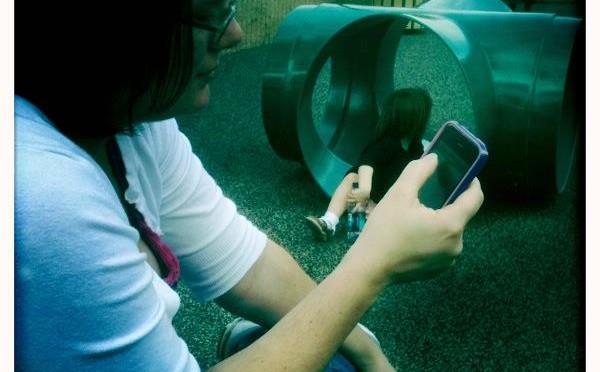I watched a TED Talk a couple weeks ago that included a simple picture. The speaker began talking about distraction, because the picture, like the one I’ve provided below, demonstrated what he meant about distraction.
The original picture was of a Dad at the park and he was playing with his smart phone while the child was playing at the park. The image left a quick and lasting impression. His own narrative did as well.
The problem I instantly had was this: 1) his response to the picture was so modernist and 2) it failed to honor the other half of his comments. Let me explain.
The modernist looks at the above picture and says “I see two people in this picture. One must be the mother and the other must be her child. She is playing with her phone, which must mean she is ignoring her child. Therefore, this is a picture of a mother ignoring her child.” Hopefully you notice all of the assumptions made that bring the modernist to come to a conclusion of judgment.
The postmodernist looks at this picture and says: “There are not two people ‘in’ this picture, but three: the woman, the child, and the picture taker. How do you suppose these three are related? Are they related? Is the picture-taker’s subject of the picture necessarily both people, but is instead the more central figure: the woman? In fact, what you bring to viewing this picture informs what the picture is actually about.”
To be fair, it was me taking a picture of my wife and daughter. And the TED speaker’s assumption in his picture is not far from true in the case of this picture in which both parents are playing with their phones while their child is playing. But this is what struck me instantly: there was an observer there judging and not acting. My brain instantly went there and said “Why aren’t you doing something about it, then?”
The original picture, intended to shame us and encourage us to be present with our children, carried with it that very intention of shame. It was created to shame. This was precipitated by crafting an artistic demonstration of the observer’s disgust. And I wasn’t comfortable with that from the moment I saw it. And this was evidently the presenter’s intention. He wanted the viewers to take responsibility in their lives. But he missed the obvious connection in his own picture.
This picture I took is one of a sequence of pictures I was taking of my wife without her knowledge. She actually was the subject of the picture. There was no shame in my heart in their taking, but love.
The problem I have with that simple, modernist response is that it, by ignoring the presence of the third figure, it ignores their complicity in the action. The observer is caught “documenting evidence” of someone else’s moral failure, judging and condescending the whole way, only to distribute a picture that would come to represent “distraction” itself to thousands of viewers. This is morally troubling and unkind.
I am also trying myself to recognize my own place in a similar moral paradigm with regards to the original picture and talk. My hope is that my readers recognize not an intention on my part to blame or shame at all, but to raise the awareness of how easy it is for us to blame and shame in hiding.
Mostly, the modernist’s way of thinking ignores the fact that the observer takes no positive responsibility to help, but takes on negative responsibility to shame.
The trouble for leaders, people of faith, and for the socially responsible in our postmodern world is to not fall into the trap of pretending we can be neutral observers or that those observing an act are somehow removed from it. Like the person who crosses the street to avoid a mugging, rather than take any steps to stop it or the grandparent that knows her own child is struggling with parenting without lending a hand or a shoulder to cry on, we actually can’t be neutral observers. It’s impossible.
Which means we are responsible for what we observe. We share in the events: the blame and the reward: because we are present: even when we pretend we are not.
How does this change how we relate to our neighbors?


Leave a Reply